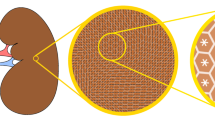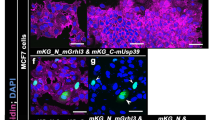Abstract
Cell polarity and cell–cell junctions have pivotal roles in organizing cells into tissues and in mediating cell–cell communication. The transmembrane protein Crumbs has a well-established role in the maintenance of epithelial polarity, and it can also regulate signalling via the Notch and Hippo pathways to influence tissue growth. The functions of Crumbs in epithelial polarity and Hippo-mediated growth depend on its short intracellular domain. Recent evidence now points to a conserved and fundamental role for the extracellular domain of Crumbs in mediating homophilic Crumbs–Crumbs interactions at cell–cell junctions.
This is a preview of subscription content, access via your institution
Access options
Subscribe to this journal
Receive 12 print issues and online access
$189.00 per year
only $15.75 per issue
Buy this article
- Purchase on Springer Link
- Instant access to full article PDF
Prices may be subject to local taxes which are calculated during checkout




Similar content being viewed by others
References
Tepass, U. Theres, C. & Knust, E. crumbs encodes an EGF-like protein expressed on apical membranes of Drosophila epithelial cells and required for organization of epithelia. Cell 61, 787–799 (1990).
Jürgens, G., Wieschaus, E., Nüsslein-Volhard, C. & Kluding, H. Mutations affecting the pattern of larval cuticle in Drosophila. Roux' Arch. Dev. Biol. 193, 283–295 (1984).
Wodarz, A., Grawe, F. & Knust, E. CRUMBS is involved in the control of apical protein targeting during Drosophila epithelial development. Mech. Dev. 44, 175–187 (1993).
Bulgakova, N. A. & Knust, E. The Crumbs complex: from epithelial-cell polarity to retinal degeneration. J. Cell Sci. 122, 2587–2596 (2009).
den Hollander, A. I. et al. Mutations in a human homologue of Drosophila crumbs cause retinitis pigmentosa (RP12). Nature Genet. 23, 217–221 (1999).
Mehalow, A. K. et al. CRB1 is essential for external limiting membrane integrity and photoreceptor morphogenesis in the mammalian retina. Hum. Mol. Genet. 12, 2179–2189 (2003).
Omori, Y. & Malicki, J. oko meduzy and related crumbs genes are determinants of apical cell features in the vertebrate embryo. Curr. Biol. 16, 945–957 (2006).
Tepass, U. The apical polarity protein network in Drosophila epithelial cells: regulation of polarity, junctions, morphogenesis, cell growth, and survival. Annu. Rev. Cell Dev. Biol. 28, 655–685 (2012).
Zou, J., Wang, X. & Wei, X. Crb apical polarity proteins maintain zebrafish retinal cone mosaics via intercellular binding of their extracellular domains. Dev. Cell 22, 1261–1274 (2012).
Fletcher, G. C., Lucas, E. P., Brain, R., Tournier, A. & Thompson, B. J. Positive feedback and mutual antagonism combine to polarize Crumbs in the Drosophila follicle cell epithelium. Curr. Biol. 22, 1116–1122 (2012).
Röper, K. Anisotropy of Crumbs and aPKC drives myosin cable assembly during tube formation. Dev. Cell 23, 939–953 (2012).
Letizia, A., Ricardo, S., Moussian, B., Martin, N. & Llimargas, M. A functional role of the extracellular domain of Crumbs in cell architecture and apicobasal polarity. J. Cell Sci. 22 March 2013 (doi:10.1242/jcs.122382).
Wodarz, A., Hinz, U., Engelbert, M. & Knust, E. Expression of crumbs confers apical character on plasma membrane domains of ectodermal epithelia of Drosophila. Cell 82, 67–76 (1995).
Klebes, A. & Knust, E. A conserved motif in Crumbs is required for E-cadherin localisation and zonula adherens formation in Drosophila. Curr. Biol. 10, 76–85 (2000).
den Hollander, A. I. et al. CRB1 has a cytoplasmic domain that is functionally conserved between human and Drosophila. Hum. Mol. Genet. 10, 2767–2773 (2001).
den Hollander, A. I. et al. Leber congenital amaurosis and retinitis pigmentosa with Coats-like exudative vasculopathy are associated with mutations in the crumbs homologue 1 (CRB1) gene. Am. J. Hum. Genet. 69, 198–203 (2001).
Morais-de-Sa, E. Mirouse, V. & St. Johnston, D. aPKC phosphorylation of Bazooka defines the apical/lateral border in Drosophila epithelial cells. Cell 141, 509–523 (2010).
Walther, R. F. & Pichaud, F. Crumbs/DaPKC-dependent apical exclusion of Bazooka promotes photoreceptor polarity remodeling. Curr. Biol. 20, 1065–1074 (2010).
Krahn, M. P., Buckers, J., Kastrup, L. & Wodarz, A. Formation of a Bazooka–Stardust complex is essential for plasma membrane polarity in epithelia. J. Cell Biol. 190, 751–760 (2010).
Lotery, A. J. et al. Mutations in the CRB1 gene cause Leber congenital amaurosis. Arch. Ophthalmol. 119, 415–420 (2001).
Alves, C. H. et al. Loss of CRB2 in the mouse retina mimics human retinitis pigmentosa due to mutations in the CRB1 gene. Hum. Mol. Genet. 22, 35–50 (2012).
Pellikka, M. et al. Crumbs, the Drosophila homologue of human CRB1/RP12, is essential for photoreceptor morphogenesis. Nature 416, 143–149 (2002).
Izaddoost, S., Nam, S. C., Bhat, M. A., Bellen, H. J. & Choi, K. W. Drosophila Crumbs is a positional cue in photoreceptor adherens junctions and rhabdomeres. Nature 416, 178–183 (2002).
van de Pavert, S. A. et al. Crumbs homologue 1 is required for maintenance of photoreceptor cell polarization and adhesion during light exposure. J. Cell Sci. 117, 4169–4177 (2004).
Chartier, F. J., Hardy, E. J. & Laprise, P. Crumbs limits oxidase-dependent signaling to maintain epithelial integrity and prevent photoreceptor cell death. J. Cell Biol. 198, 991–998 (2012).
Robinson, B. S., Huang, J., Hong, Y. & Moberg, K. H. Crumbs regulates Salvador/Warts/Hippo signaling in Drosophila via the FERM-domain protein Expanded. Curr. Biol. 20, 582–590 (2010).
Grzeschik, N. A., Parsons, L. M., Allott, M. L., Harvey, K. F. & Richardson, H. E. Lgl, aPKC, and Crumbs regulate the Salvador/Warts/Hippo pathway through two distinct mechanisms. Curr. Biol. 20, 573–581 (2010).
Ling, C. et al. The apical transmembrane protein Crumbs functions as a tumor suppressor that regulates Hippo signaling by binding to Expanded. Proc. Natl Acad. Sci. USA 107, 10532–10537 (2010).
Chen, C. L. et al. The apical–basal cell polarity determinant Crumbs regulates Hippo signaling in Drosophila. Proc. Natl Acad. Sci. USA 107, 15810–15815 (2010).
Herranz, H., Stamataki, E., Feiguin, F. & Milan, M. Self-refinement of Notch activity through the transmembrane protein Crumbs: modulation of γ-secretase activity. EMBO Rep. 7, 297–302 (2006).
Richardson, E. C. & Pichaud, F. Crumbs is required to achieve proper organ size control during Drosophila head development. Development 137, 641–650 (2010).
Ohata, S. et al. Dual roles of Notch in regulation of apically restricted mitosis and apicobasal polarity of neuroepithelial cells. Neuron 69, 215–230 (2011).
Tanentzapf, G. & Tepass, U. Interactions between the crumbs, lethal giant larvae and bazooka pathways in epithelial polarization. Nature Cell Biol. 5, 46–52 (2003).
Klose, S., Flores-Benitez, D., Riedel, F. & Knust, E. Fosmid-based structure-function analysis reveals functionally distinct domains in the cytoplasmic domain of Drosophila crumbs. G3 (Bethesda) 3, 153–165 (2013).
Bilder, D., Schober, M. & Perrimon, N. Integrated activity of PDZ protein complexes regulates epithelial polarity. Nature Cell Biol. 5, 53–58 (2003).
Knoblich, J. A. Asymmetric cell division: recent developments and their implications for tumour biology. Nature Rev. Mol. Cell Biol. 11, 849–860 (2010).
Campbell, K., Knust, E. & Skaer, H. Crumbs stabilises epithelial polarity during tissue remodelling. J. Cell Sci. 122, 2604–2612 (2009).
Grawe, F., Wodarz, A., Lee, B., Knust, E. & Skaer, H. The Drosophila genes crumbs and stardust are involved in the biogenesis of adherens junctions. Development 122, 951–959 (1996).
Zallen, J. A. & Wieschaus, E. Patterned gene expression directs bipolar planar polarity in Drosophila. Dev. Cell 6, 343–355 (2004).
Simoes Sde, M. et al. Rho-kinase directs Bazooka/Par-3 planar polarity during Drosophila axis elongation. Dev. Cell 19, 377–388 (2010).
den Hollander, A. I. et al. CRB1 mutation spectrum in inherited retinal dystrophies. Hum. Mutat. 24, 355–369 (2004).
Richard, M., Muschalik, N., Grawe, F., Ozuyaman, S. & Knust, E. A role for the extracellular domain of Crumbs in morphogenesis of Drosophila photoreceptor cells. Eur. J. Cell Biol. 88, 765–777 (2009).
Harris, K. P. & Tepass, U. Cdc42 and Par proteins stabilize dynamic adherens junctions in the Drosophila neuroectoderm through regulation of apical endocytosis. J. Cell Biol. 183, 1129–1143 (2008).
Hafezi, Y., Bosch, J. A. & Hariharan, I. K. Differences in levels of the transmembrane protein Crumbs can influence cell survival at clonal boundaries. Dev. Biol. 368, 358–369 (2012).
Pichaud, F. & Desplan, C. Cell biology: a new view of photoreceptors. Nature 416, 139–140 (2002).
Grusche, F. A., Degoutin, J. L., Richardson, H. E. & Harvey, K. F. The Salvador/Warts/Hippo pathway controls regenerative tissue growth in Drosophila melanogaster. Dev. Biol. 350, 255–266 (2011).
Varelas, X. et al. The Crumbs complex couples cell density sensing to Hippo-dependent control of the TGF-β–SMAD pathway. Dev. Cell 19, 831–844 (2010).
Zhao, B. et al. Inactivation of YAP oncoprotein by the Hippo pathway is involved in cell contact inhibition and tissue growth control. Genes Dev. 21, 2747–2761 (2007).
Windler, S. L. & Bilder, D. Endocytic internalization routes required for Delta/Notch signaling. Curr. Biol. 20, 538–543 (2010).
Pardossi-Piquard, R. et al. Overexpression of human CRB1 or related isoforms, CRB2 and CRB3, does not regulate the human presenilin complex in culture cells. Biochemistry 46, 13704–13710 (2007).
Mitsuishi, Y. et al. Human CRB2 inhibits γ-secretase cleavage of amyloid precursor protein by binding to the presenilin complex. J. Biol. Chem. 285, 14920–14931 (2010).
Niewiadomska, P., Godt, D. & Tepass, U. DE-cadherin is required for intercellular motility during Drosophila oogenesis. J. Cell Biol. 144, 533–547 (1999).
Pinheiro, E. M. & Montell, D. J. Requirement for Par-6 and Bazooka in Drosophila border cell migration. Development 131, 5243–5251 (2004).
Pocha, S. M., Wassmer, T., Niehage, C., Hoflack, B. & Knust, E. Retromer controls epithelial cell polarity by trafficking the apical determinant Crumbs. Curr. Biol. 21, 1111–1117 (2011).
Harris, T. J. & Tepass, U. Adherens junctions: from molecules to morphogenesis. Nature Rev. Mol. Cell Biol. 11, 502–514 (2010).
Chen, W. S. et al. Asymmetric homotypic interactions of the atypical cadherin flamingo mediate intercellular polarity signaling. Cell 133, 1093–1105 (2008).
Yue, T., Tian, A. & Jiang, J. The cell adhesion molecule Echinoid functions as a tumor suppressor and upstream regulator of the Hippo signaling pathway. Dev. Cell 22, 255–267 (2012).
Chang, L. H. et al. Differential adhesion and actomyosin cable collaborate to drive Echinoid-mediated cell sorting. Development 138, 3803–3812 (2011).
Acknowledgements
The authors apologize to colleagues whose work could not be cited or discussed in sufficient depth owing to space limitations. B.J.T. is supported by Cancer Research UK (CRUK), F.P. is supported by the Medical Research Council (MRC), and K.R. is also supported by the MRC (file reference number U105178780).
Author information
Authors and Affiliations
Corresponding authors
Ethics declarations
Competing interests
The authors declare no competing financial interests.
Related links
Related links
FURTHER INFORMATION
Rights and permissions
About this article
Cite this article
Thompson, B., Pichaud, F. & Röper, K. Sticking together the Crumbs — an unexpected function for an old friend. Nat Rev Mol Cell Biol 14, 307–314 (2013). https://doi.org/10.1038/nrm3568
Published:
Issue Date:
DOI: https://doi.org/10.1038/nrm3568
This article is cited by
-
Novel variants in CRB2 targeting the malfunction of slit diaphragm related to focal segmental glomerulosclerosis
Pediatric Nephrology (2024)
-
Bi-allelic variations in CRB2, encoding the crumbs cell polarity complex component 2, lead to non-communicating hydrocephalus due to atresia of the aqueduct of sylvius and central canal of the medulla
Acta Neuropathologica Communications (2023)
-
Comprehensive identification of mRNA isoforms reveals the diversity of neural cell-surface molecules with roles in retinal development and disease
Nature Communications (2020)
-
The regulation of junctional actin dynamics by cell adhesion receptors
Histochemistry and Cell Biology (2018)
-
CRB3 regulates contact inhibition by activating the Hippo pathway in mammary epithelial cells
Cell Death & Disease (2017)



